| Date | Event or Document | Image or PDF |
1/11/05 | Historian Katherine J. Rinehart writes to Chief of San Francisco District, U.S. Army Corps of Engineers “to express my concerns about the proposed demolition of the historic Petaluma Trestle” “The Trestle remains the most tangible and visual link to Petaluma's important transportation and agricultural history and is a distinct component of the downtown landscape as such, I ask that prior to issuing any permits for this project that you consult with the State Historic Preservation Officer and conduct a Section 106 Review”
|  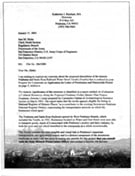
|
1/26/05 | Chris Stevick’s presentation to SPARC, summarized in a letter listing the extensive benefits to Petaluma stemming directly from saving the Trestle. I believe the Trestle's historic significance has been overlooked by those who propose to demolish it. It is our visual and historic connection to Petaluma's own unique past.
The Trestle has been described for years as one of a kind in existence on the West coast. So far I have not been able to find any other like it. It may be completely unique. It is certainly a contributor to the uniqueness and charm of Petaluma.
The "WATER STREET TRESTLE EVALUATION AND REPLACEMENT" 1/29/02, CSW [St] should have considered replacing the pilings of the existing structure. But it never did. I quote from page 3: "As stated, each of these scenarios assumes the complete removal of the existing trestle"
|  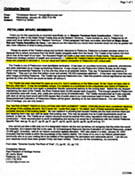
|
2/9/05 | Paul Marangella's presentation to the board of Heritage Homes asserting all the reasons the trestle can’t be saved. Recorded & noted in the meeting minutes. Paul Marangella encouraged the HH Board to approve new concrete terminus of Western Street at Water Street. Plans reviewed showed a concrete deck supported by concrete piers. All studies and proposals had included demolition of historic RR trestle.
After spending $107,000 on studies and proposals the City of Petaluma halted funding for design alternatives involving trestle demolition and City staff announced their intention to delete $400,000 in funding for trestle demolition from budget at February budget review.
|  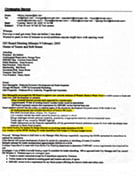 |
| Early 2005 | Paul Marangella pressures Kit Schlich, new HH president, to “ OK” Trestle demolition. Kit Schlich, in a letter to the Heritage Homes Board and Chris Stevick, dated Aug 6, 2013, recounted her experience with Marangella in early 2005 after she became president of Heritage Homes. "When I became HH president in 2005, Paul Marangella, head of city development, invited me to his office to present a city engineer's plan to demo the trestle and replace it with a generic modern embankment topped by a walkway. He badly wanted the neophyte (me) to approve it. But I didn't. The HH board at the time backed me up and I realized that this was to be an issue of importance to the preservation community."
|  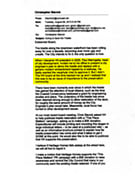 |
2005 | Friends of the Water Street Trestle form an ad hoc support group to show this is not just a trolley issue This informal group of local people (including Pam Torliatt, who would later be elected mayor) were determined to preserve the Trestle, and eventually helped secure a grant from the State Coastal Conservancy for the restoration of the Trestle
| |
5/25/05 | Argus-Courier article "Downtown trolley effort still on track" “City officials maintain their information shows the Trestle is beyond repair”
|  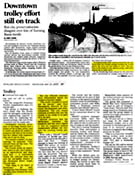 |
9/12/05 | Chris sends letter to Paul Marangella with attached drawings from structural engineers at MKM & Associates showing how Trestle could be repaired rather than demolished. To rebut Marangella’s claim that "no engineer would put his stamp on a wooden trestle"
Chris hired MKM to show that a structural engineer WOULD sign off on a wood trestle, assuming it was restored properly.. Since pilings below low waterline (in the anoxic or anaerobic zone) are still solid, the only work required to salvage the pilings (and therefore the Trestle) is to repair the damaged portion between high and low waterline or replace and mechanically connect new material to the sound pilings below. The caps and sleepers supported by the pilings are still in good shape. Only the top decking would need to be replaced.
Click on the image to the right to see the entire document:
Pg 1 Cover letter from Chris Stevick to Paul Marangella
Pg 2 Assumptions and basic requirements
Pg 3 Drawing of a possible solution
Pg 4 Reproduction of “So. Pacific Lines Common Standard Method of Splicing Trestle Piles” dated 12/2/1954, showing drawings of several methods of trestle repair.
|  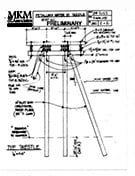 |
| 10/12/05 | Argus-Courier article "Redevelopment boss leaves city hall" "Marangella, who said he was asked to resign following the discovery of $4.8 million in unpaid redevelopment bills." "informed sources said Marangella sometimes went outside of his authority while leading the city's redevelopment push, authorizing more spending on projects that the city later had to OK."
Editor's note--Marangella apparently forgot to mention he had authorized $4.8 M in infrastructure costs for the Theater District development in excess of the original budgeted amount. The City of Petaluma was forced to use their budget surplus funds to cover the debt. Marangella was asked to "retire" and he accepted, effective January 1, 2006.
|  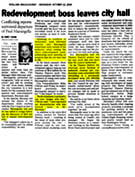 |
4/5/06 | Dutra Construction provides cost estimate for restoring Trestle "36 piers with 4 piles each = 144 piles (assume 50' each) @ $80 per foot (treated and wrapped) = $576,000.00
Install Piles - 144 each @ $1200 per each = $172,800.00
Remove old deck to get access to piers = $50,000.00 (includes disposal)
Replace deck after piers installed = $40,000.00 (buy decking and install)
Replace Ties as necessary = $15,000.00 (will need to remove and replace at least 72 ties)
Remove and dispose of old piling (180 each say $250 per each) = $45,000.00
TOTAL = $898,800.00 cost.
BID would probably be in the range of $1.2 million from any contractor." .
|  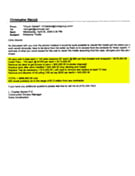 |